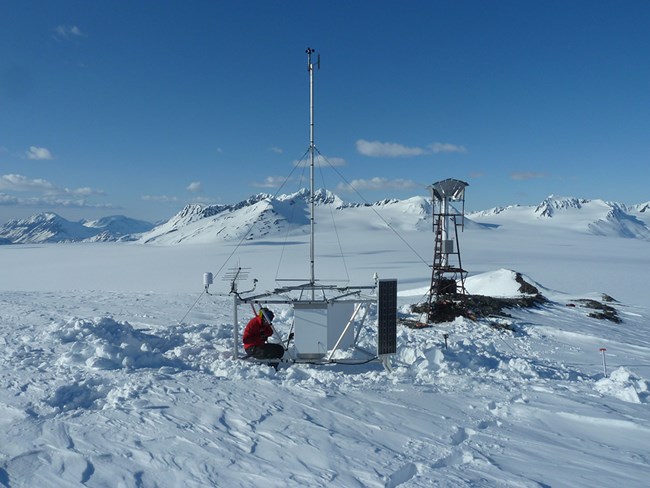Climate is a fundamental driver of ecology. Physical characteristics of a region provide a foundation that defines the parameters of the ecosystems.
The climate patterns of Alaska are primarily influenced by latitude, continentality, and elevation. The high latitude drives the seasonal pattern of available solar radiation. The Arctic has limited incoming solar warmth in the winter and an abundance of available light in the summer. Major mountain ranges in Alaska act as barriers to the moisture spinning off the Pacific Ocean to the south. The warm, moist air masses deposit precipitation on the windward sides of the mountains – rain at low elevations and snow at higher elevations. Large-scale atmospheric and oceanic circulation patterns influence seasonal and annual weather patterns in the state, like the repositioning of the polar jet stream and the Aleutian low-pressure system or the frequency of La Niña and El Niño patterns. Each of these can affect the regional storm tracks, prevailing winds, snowfall amounts, and the extent of sea ice.
Climate Trends in Alaska
The climate is changing. Climate will change in different ways, over different time scales, and at different geographical scales based on the local factors or physical conditions.
Climate impacts many aspects of park management, from ecological systems to park infrastructure. The climate is changing and human influence is now detectable in nearly all major components of the climate system, including the atmosphere and oceans, snow and ice, and various aspects of the water cycle (IPCC 2013). Global patterns of change that demonstrate the human effects on climate are even more pronounced in high latitudes (Larsen et al. 2014). As a region, Alaska has warmed more than twice as rapidly as the rest of the United States over the past 60 years, with average annual air temperature increasing by 3 °F and average winter temperature increasing by 6 °F (Chapin et al. 2014). The observed warming is part of a larger trend through most of the
Even with multiple lines of evidence that Alaska is warming, interpreting temperature trends and other climatic indicators is complicated. Climate in Alaska is dynamic and nonlinear, with strong linkages to atmospheric and oceanic processes, such as the position of the polar jet stream or the frequency of El Niño events (Papineau 2001). An important climate pattern, evident in the relatively few long-term climate stations located in parks, is the Pacific Decadal Oscillation (PDO). Much of the warming that has occurred since the middle of the 20th century occurred in 1976 as a stepwise shift, attributed to a climatic transition from a cool to a warm phase in the PDO (Chapin et al. 2014, Bieniek and Walsh 2014).

In the early 2000s, the PDO shifted back to a cooler phase resulting in statewide temperatures that were cooler than the previous decades (Bieniek and Walsh 2014). The most recent years have seen yet another shift back to a warm phase that may or may not persist, but has resulted in five of the warmest years on record for Alaska since 2014 (NOAA 2019). The North Slope of Alaska has continued to warm, despite changes in the PDO.
Nonlinear responses and regional variations are expected to continue to occur as the planet adjusts to global-scale change (IPCC 2013, Larsen et al. 2014). Recent studies suggest that warming Arctic temperatures weaken the temperature gradient between the poles and lower latitudes leading to a wavier (or wobbly) jet stream, which results in more persistent weather patterns and extreme conditions such as cold spells, heat waves, droughts, and flooding (Francis and Vavrus 2015).

NPS Alaska Climate Monitoring
Records of temperature and precipitation are especially important to document climate and understanding its effects on ecosystems. Strategic deployment of new climate stations in Alaska’s parks provide data not heretofore available on climate patterns and extreme events, such as floods, droughts, and severe temperatures. In addition, the climate stations provide real-time weather data, which is of immediate use to park management and park operations. The data and information gathered from national parks provide an important piece of the puzzle in understanding both the drivers and effects of climate change.
Learn more about climate monitoring in Alaska’s Inventory & Monitoring Networks:
Arctic Network
Central Alaska Network
Southeast Alaska Network
Southwest Alaska Network
Last updated: September 6, 2023
